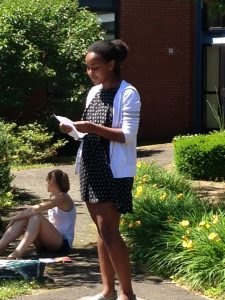Written by Diana Ajjan, 7th Grade English Teacher
 The spring sunshine warmed their backs as 100 7th graders in Northampton, MA, swarmed from JFK Middle School to Look Park. They buzzed with their friends the whole way, parting into groups as they entered the park, each following its adult leader to a quiet spot. Some alighted on a wooden dock overlooking a glistening pond; others dangled their legs into a bubbling brook; still others nestled in soft blades of new grass. After a long New England winter, students eagerly shed their sweatshirts and shoes to feel the sun and blushes of breeze against their skin.
The spring sunshine warmed their backs as 100 7th graders in Northampton, MA, swarmed from JFK Middle School to Look Park. They buzzed with their friends the whole way, parting into groups as they entered the park, each following its adult leader to a quiet spot. Some alighted on a wooden dock overlooking a glistening pond; others dangled their legs into a bubbling brook; still others nestled in soft blades of new grass. After a long New England winter, students eagerly shed their sweatshirts and shoes to feel the sun and blushes of breeze against their skin.
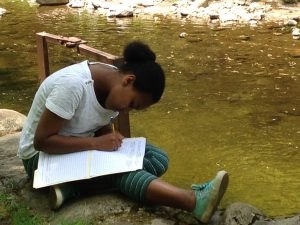
After a quick warm up of their senses, student worker bees busily began recording sense imagery on a chart: a hawk circling above, the musty smell of earth, the squirrel scampering between tall pines, the rustle of leaves and snapping sticks, a fish floating beneath the pond’s still surface Once they recorded these images, they set to work pairing them with descriptive words. All of this activity, they knew, was leading them to writing a poem based on their observations of the natural world.
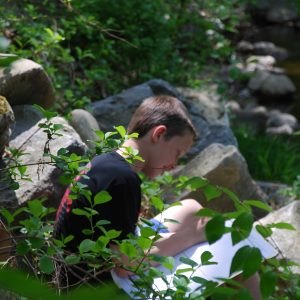
After drafting, revising, and tweaking, they set to work on an observation of their inner landscape: thoughts, joys, worries, wonderings recorded on a chart. The bees buzzed a bit aimlessly this time, unsure of how this would translate to a poem which was not grounded in something concrete. When students asked what they were supposed to write, the teacher answered vaguely: “I’m not sure…it depends….use your recorded thoughts as inspiration…just write and see what comes out…” Not satisfactory answers for seventh grade bees. But write they did, to both their own delighted astonishment and that of their teacher. Students felt the power of poetry for self-expression in relation to both the outer and inner world.
 Students were going to be a bit wary and pleasantly surprised yet again for the next step in the evolution of their poetry. Each was asked to highlight their best or favorite line in each poem. Then, each chose one line to contribute to a whole team (5-class) poem, writing it on a strip of paper. They then, in each class, scattered their lines on a table and set to work composing their class’s stanza. The teacher walked around the group of busy bees, snapping pictures of them demonstrating their language and poetry skills. They grouped lines by images, read, reread, shuffled,read; when finally satisfied with line order, they added punctuation with purpose and tweaked an occasional word choice if it wasn’t “juicy” enough.
Students were going to be a bit wary and pleasantly surprised yet again for the next step in the evolution of their poetry. Each was asked to highlight their best or favorite line in each poem. Then, each chose one line to contribute to a whole team (5-class) poem, writing it on a strip of paper. They then, in each class, scattered their lines on a table and set to work composing their class’s stanza. The teacher walked around the group of busy bees, snapping pictures of them demonstrating their language and poetry skills. They grouped lines by images, read, reread, shuffled,read; when finally satisfied with line order, they added punctuation with purpose and tweaked an occasional word choice if it wasn’t “juicy” enough.
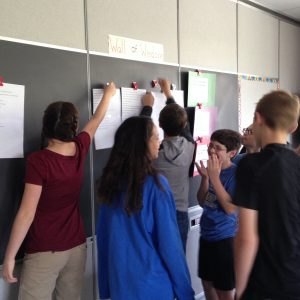
The teacher typed the 5 stanzas and hung them on the wall. Again, she stepped back as students in each class read the stanzas, marveling at their melded work and how “a bunch of random lines” could actually become a “real poem”. The teacher suggested that it worked because poetry is a universal form of art and communication; that anyone with a heart and mind can express his/herself in a poem, and anyone with a heart and mind can read a poem and relate to it in some way. Poetry universalizes our experience of the world, both outer and inner, which is why all 100 students could write a poem together. Each class of busy bees read and shuffled stanzas, and by the end of the day, a poem was born.
Knowing that poetry is universal in nature and meant to be shared, students created a “river of words” mural to display their writing. They painted the river banks with sand, rocks, and plants and inscribed their lines on tiles that would form their river.
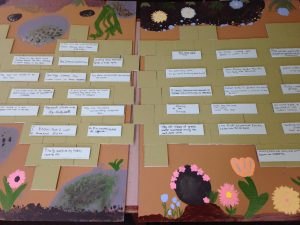
On the very last day of school, the drone of worker bees slowed down in the increasing heat of impending summer. They swarmed into the school’s courtyard to drink in their river of words, then mingled with friends before settling on the warm dry grass, some squished under the shade of a poplar. One by one, brave bees stood on a stump to read one of their poems. Fingers clicked in appreciation. As they wound down, these bees enjoyed fruity sweet Italian ice, together as a swarm for the last time that school year, joined and inspired by each other’s words, empowered by language they harnessed and created through poetry.
